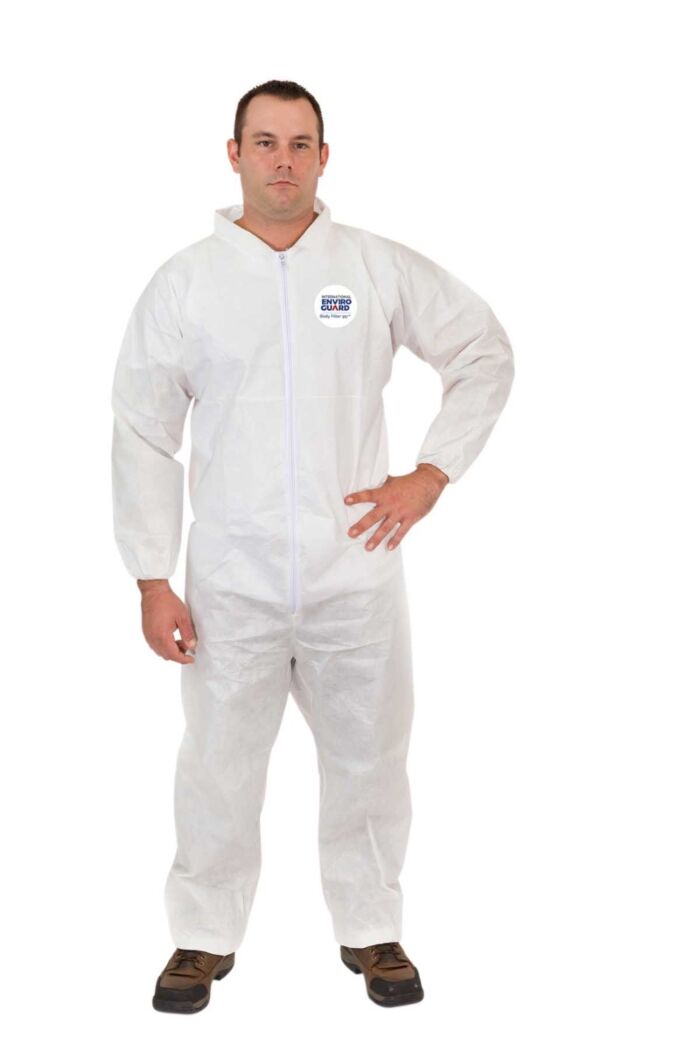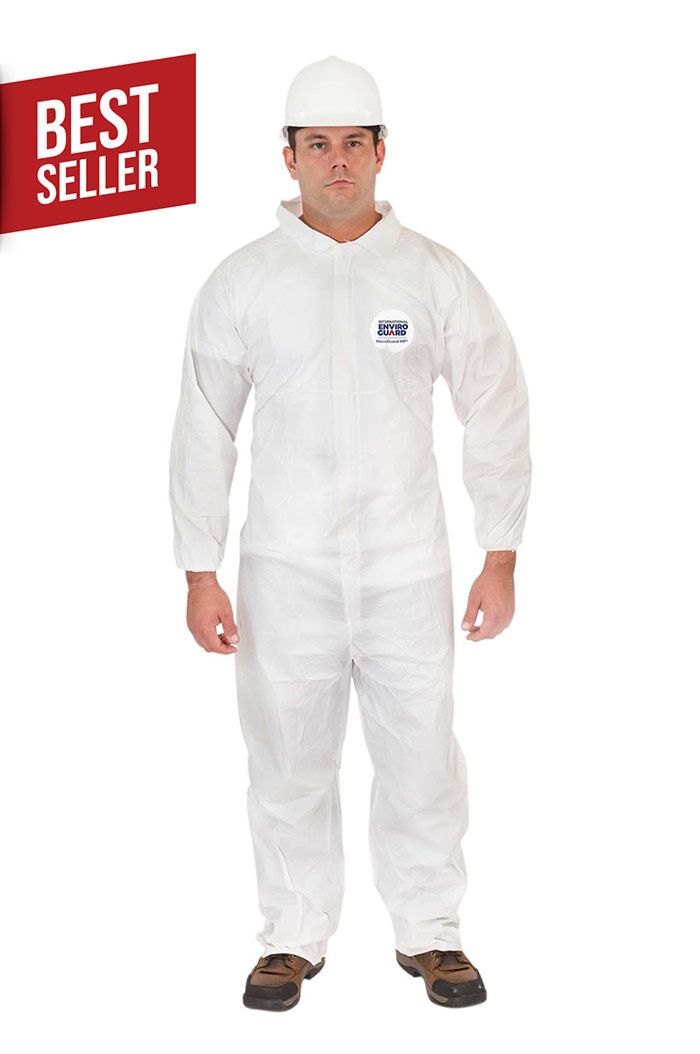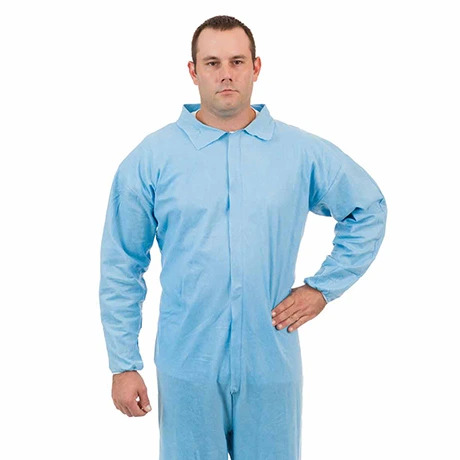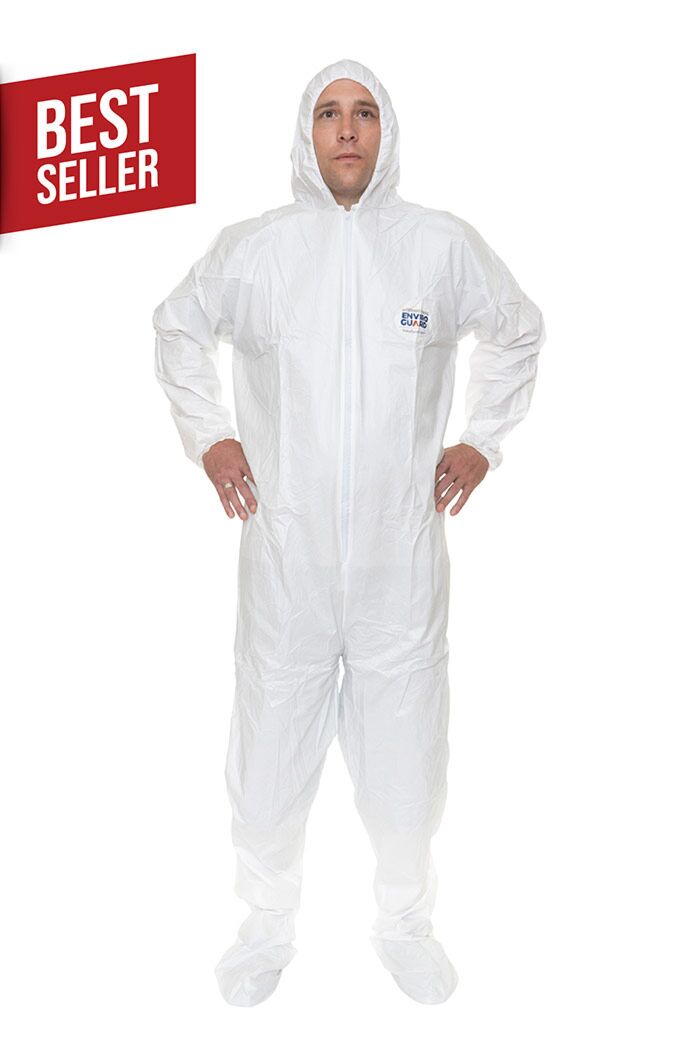We use cookies to make your experience better. To comply with the new e-Privacy directive, we need to ask for your consent to set the cookies. Learn more.
PPE for Painters and Paint Applications
As a painter, you expose yourself to harmful chemicals and toxic fumes every time you take on a new painting project. Short or long-term exposure to commercial or industrial-grade paint can cause health problems such as skin irritation and eye irritation, or other more serious medical issues such as respiratory damage.
How do you protect yourself from these job-related risks when you’re on the job site? The answer is disposable paint suits. The appropriate disposable painters’ coveralls will prevent the absorption of paint far better than regular clothing.
Disposable Painters Suits from International Enviroguard
International Enviroguard offers several disposable suit styles for painters in a variety of applications from automotive paint suits to painters coveralls for commercial projects, and more:
Protective Coveralls for Brush and Roller Applications
Painting with a brush or a roller often creates paint drips, splashes, spills, or situations where paint gets rubbed into protective clothing. This type of work is common when painting walls and ceilings, or wood such as door frames and windowsills.
Jobs that require this type of safety suit include home renovations, commercial paint jobs, general contractors, DIY projects, and more. International Enviroguard offers two lines of painters’ suits for brush and/or roller applications—ValuGuard MP™ and MicroGuard MP®. Both product lines offer a variety of styles with or without an attached hood, and with or without attached boots. They also include features designed for wearer comfort such as elastic backing, seamless shoulder areas to prevent rips and tears, and wider crotch areas that also help prevent rips or tears when squatting or bending.
ValuGuard MP™
Protects against splashes, sprays, and particulates. Its lightweight microporous fabric is designed to keep workers cool to avoid heat stress. Whether you’re painting indoors or outdoors, these painters’ suits help release heat, so you stay cool and comfortable over long hours.
MicroGuard MP®
Protective clothing combines a soft, non-woven fabric with a microporous film. This creates a tear-resistant fabric that repels liquids, splashes, and sprays. Fabric is low linting and also offers a particulate barrier. These painters’ suits have a high moisture vapor transmission rate (MVTR) meaning they allow moisture vapor and heat to escape, so workers stay cool throughout indoor and outdoor jobs.
Disposable Coveralls for Overspray Applications
Overspray applications, such as spray painting and coating applications, require a painter’s suit that protects against particulates. Overspray is considered a particulate due to the paint droplets extremely small size. Overspray and coating are common in automotive paint work, industrial paint jobs, contract work, construction, and more. For paint work that involves overspray and coatings, Body Filter 95+® provides heavy duty particulate protection. These breathable paint suits are engineered to protect against hazardous and noxious particulates down to 0.3 microns in the 95% to 99% range. This product line also features styles with or without an attached hood, and with or without attached boots. Accessories include sleeves and shoe covers.
Paint Suits for Refineries or For Flame Risks
When working in an environment with the potential for sparks, flammable paints and coatings can pose a serious risk. Painting in confined spaces or areas with poor ventilation significantly increases the risk of combustion. Luckily, International Enviroguard’s PyroGuard FR® is flame resistant. The fabric is made with a phosphate-based fire retardant that deprives flames of their fuel source to prevent the spread of flames. Fabric also chars to prevent molten drips that can also injure workers. This product line passes ASTM D6413 vertical flame resistance tests to ensure protection against combustible vapors.
Choosing Disposable Painters Overalls for the Right Type of Paint
The health effects of paint should not be overlooked. Some types of paint have little to no toxicity, while others can be harmful to inhale, but not harmful to the skin. The most toxic types of paint can be detrimental upon contact or ingestion. The three most common types of paint that professionals use include:
1. Protection from Latex Paints
Exterior latex paint contains mercy. This substance acts as a paint preservative, as well as an agent that kills bacteria. Latex paint fumes contain volatile organic compounds (VOCs) such as toluene, formaldehyde, and benzene. Workers that are exposed to these types of compounds can suffer from a wide range of health issues if exposed for long periods.
2. Protection from Oil-Based Paints
Oil-based paints may contain toxic elements such as hydrocarbons and high levels of VOCs. Consequently, the most significant health issues that can occur as a result of inhalation or paint poisoning include skin irritation, vision problems, respiratory conditions, coughing, disorientation, accelerated heart rate, or sinus complications.
The Environmental Protection Agency states that some VOCs in oil-based paints may cause cancer. Exposure to oil-based paint may also cause organ and central nervous system failure. Some workers may be particularly sensitive to oil-based paint and will experience dizziness or upset stomach if exposed for long periods. They may also have difficulty breathing or develop rashes on the skin.
3. Protection from Solvent-Based Paints
Solvent-based paints can cause greater skin irritation or ingestion problems than other types of paint. Workers that inhale solvent fumes may experience medical issues with the lungs. Long-term inhalation can also lead to severe headaches, upset stomach, or dizziness.
Whether painters are applying paint with a brush, a roller, or a sprayer, the skin can absorb paint fumes and particles through the air. Wearing paint suits can help reduce or eliminate health risks by shielding the skin from all paint toxins and fumes during paint jobs.
Look for a Disposable Painters Suit with Optimal Breathability & Comfort
When it comes to disposable paint suits, you don’t have to sacrifice comfort for safety. One of the characteristics of quality, disposable suits is moisture vapor transmission rate (MVTR). Paint coveralls should allow body heat and sweat vapor to pass through the suit without compromising the permeability of the material against chemicals and paint fumes.
Comfortable painters’ coveralls provide more flexibility in the shoulder and back area, so workers can utilize paint equipment more efficiently and enjoy freedom of movement. A gusseted crotch area gives workers the ability to squat, bend, and climb with a lower likelihood of tearing the suit.
Make Sure the Disposable Painters Suit is Durable
Durability is a crucial element in selecting disposable paint suits. The material must be rugged, puncture-resistant, and be able to withstand intense work environments.
The best paint suits contain advanced lamination technology that combines soft non-woven fabric with a microporous film. This material creates a liquid and particulate barrier that protects the worker from exposure to toxic substances.
Buy Disposable & Recyclable Painters Overalls
Disposable paint suits may seem like a cheap alternative to more expensive, reusable suits that workers keep and wash over and again. However, disposable suits offer the same level of protection against paint particles and fumes as multi-use suits, but with the following advantages:
- Disposable suits are a more cost-effective solution without the need for laundering or repairs
- Rather than waste money on water consumption and cleaning supplies, workers can dispose of the suit one or more times per day
- Disposable suits are recyclable. Manufacturers can fabricate paint suits for reuse many times over
Make Sure the Coveralls Meet OSHA Regulations
According to OSHA regulations, all workers exposed to paint must wear personal protective equipment (PPE) whenever the painter is exposed to potential hazards that arise from chemical exposure such as commercial or industrial paint.
Disposable paint suits must shield or isolate workers from the chemical effects of paint that could cause immediate medical issues such as skin irritation or burning, as well as long-term health issues via inhalation that leads to respiratory problems over time.
OSHA explains that both exposure to paint substances and the health risks that it has on workers is not always apparent or immediately noticeable. Therefore, employers must be proactive in choosing the right disposable suit that prevents potential problems before they occur.



